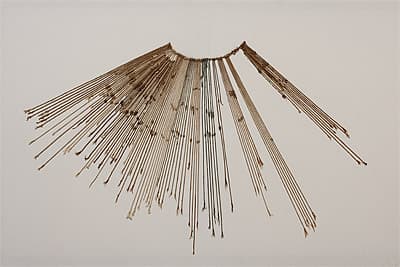
INCA culture 1400 – 1533 AD
Quipu 1400-1533 AD cotton65.0 (h) x 106.0 (w) cm Museo Larco, Lima Photograph: Daniel Giannoni
Quipus, made from knotted cords of cotton or wool, were used to record amounts of goods and numbers of people in the bureaucratic and centralised Inca Empire. Computations were decimal, the highest row of knots standing for one, the next for ten and so on. Different colours, lengths of cords, types of knots and number of plies all changed the meaning. The use of quipus was widespread in Andean civilisations such as the Huari, but the Incans often claimed earlier inventions and discoveries.
Quipus, made from knotted cords of cotton or wool, were used to record amounts of goods and numbers of people in the bureaucratic and centralised Inca Empire. Computations were decimal, the highest row of knots standing for one, the next for ten and so on. Different colours, lengths of cords, types of knots and number of plies all changed the meaning. The use of quipus was widespread in Andean civilisations such as the Huari, but the Incans often claimed earlier inventions and discoveries.
Quipus, made from knotted cords of cotton or wool, were used to record amounts of goods and numbers of people in the bureaucratic and centralised Inca Empire. Computations were decimal, the highest row of knots standing for one, the next for ten and so on. Different colours, lengths of cords, types of knots and number of plies all changed the meaning. The use of quipus was widespread in Andean civilisations such as the Huari, but the Incans often claimed earlier inventions and discoveries.

